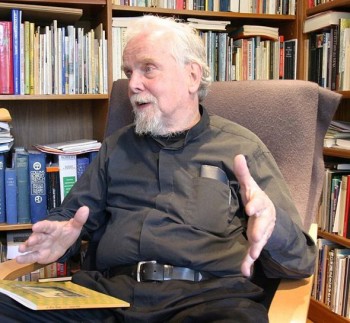Archive for February, 2013
On the meaning of translation
28 February 2013 | This 'n' that
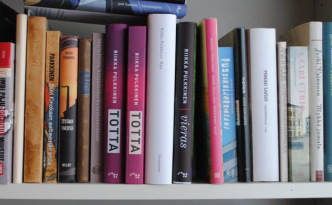 Translations of Finnish literature into English are booming, according to a new website set up by the Finnish-English Literature Translation Co-operative, or FELT.
Translations of Finnish literature into English are booming, according to a new website set up by the Finnish-English Literature Translation Co-operative, or FELT.
Or at least there is a tiny boom, as translator Lola Rogers puts it in her contribution to ‘Reflections’ on the FELT website.
Whereas less than 20 translations were published between 1992 and 2002, the number of translations published in the decade from 2002 was more than 34.The reason, according to FELT, is the new availability of qualified literary translators, whom the new website has been created to represent; each of them (David Hackston, Emily Jeremiah, Kristian London, Lola Rogers, Owen Witesman) now have two or more published Finnish works of fiction under their belts.
A significant factor has been the training events organised by FILI, Finnish Literature Exchange, publisher of this magazine – and, we might dare to say, Books from Finland itself, which offers translators a forum (as well as payment) for translations of extracts from interesting or significant new work.
The FELT website is worth a visit by anyone with an interest in Finnish literature – or translation. As well as details of published and forthcoming work, there is a collection of essays on the art of translating particular works, from Kristina Carlson (also ex-Editor-in-Chief of Books from Finland) to the novelist Asko Sahlberg and the modernist poet Eeva-Liisa Manner.
Happy days, sad days
28 February 2013 | Reviews
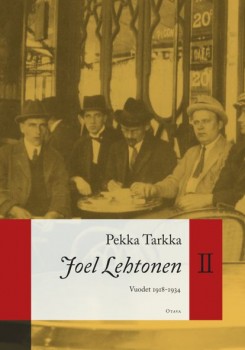 Pekka Tarkka
Pekka Tarkka
Joel Lehtonen II. Vuodet 1918–1934
[Joel Lehtonen II. The years 1918–1934]
Helsinki: Otava, 2012. 591 p., ill.
ISBN 978-951-1-25924-4
€38.50, hardback
A well-meaning bookseller’s idealism, inspired by Tolstoyan ideology, is brought crashing down by the laziness and ingratitude of the man hired to look after his estate: conflicts between the bourgeoisie and the ‘ordinary folk’ are played out in heart of the Finnish lakeside summer idyll in Savo province.
Taking place within a single day, the novel Putkinotko (an invented, onomatopoetic place name: ‘Hogweed Hollow’) is one of the most important classics of Finnish literature. Putkinotko was also the title of a series (1917–1920) of three prose works – two novels and a collection of short stories – sharing many of the same characters [here, a translation of ‘A happy day’ from Kuolleet omenapuut, ‘Dead apple trees’, 1918] .
In 1905 Joel Lehtonen bought a farmstead in Savo which he named Putkinotko: it became the place of inspiration for his writing. With an output that is both extensive and somewhat uneven, the reputation of Joel Lehtonen (1881–1934) rests largely on the merits of his Putkinotko, written between 1917 and 1920. More…
Riku Korhonen: Nuku lähelläni [Sleep close to me]
28 February 2013 | Mini reviews, Reviews
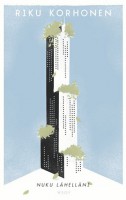 Nuku lähelläni
Nuku lähelläni
[Sleep close to me]
Helsinki: WSOY, 2012. 300 p.
ISBN 978-951-0-39305-5
€29.90, hardback
Contrary to the more agreeable expectations that might be prompted by its title, this book is dominated by the image of a masked anarchist raising his hand in a cloud of teargas. Korhonen (born 1972) is an analyst of social problems who in his most recent novels has expanded his field of vision from the realities of suburban Finland to the global centres of money and power. This novel, his fifth book, offers a pessimistic picture of Europe today. The collapse of the economy has left people with an inner sense of emptiness and anger. A young man travels to a central European financial centre to collect his brother’s corpse. The dead man had a management level job in banking, but his body is discovered with an anti- globalisation protest mask on its face. Analysis of the world situation is combined with elements of a detective thriller. The novel’s love affair is likened to a business deal: capital, profit and risk are equated with desire, hope and sorrow. This anti-capitalist metaphor is a typical theme of contemporary Finnish prose fiction.
Translated by David McDuff
Far from the madding crowd
21 February 2013 | Articles, Non-fiction
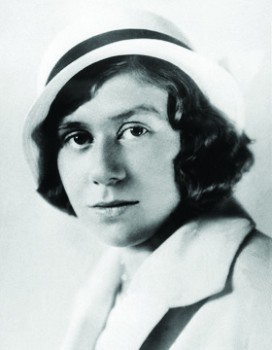
Saima Harmaja (1913–1937). Photo: WSOY
‘I don’t belong to the crowd,’ the young Saima Harmaja wrote in her diary in 1933. Her work as a poet was for her a vocation that superseded everything else. In her diaries she often speaks as a sociable young woman, with a delicious sense of humour, but her best poems seriously explore love, and death which cast its shadow over her. A selection of her poems – the best of which have made her a Finnish classic – is now published in English for the first time
In her diary the young poet claimed: ‘I think I would die if I could not write.’ What Harmaja shared with the poets of the early part of the twentieth century who influenced her was the private and personally experienced nature of poetry itself, rather than the realisation of any current aesthetic programme.
Harmaja is one of those poets whose works have passed through the hands of readers from decade to decade. She is also a prototype of the poet of her generation: gifts that led to the expectation of a brilliant career, a life that was brought to a tragic end by tuberculosis, leaving just five years of work as a poet. More…
All the grace
21 February 2013 | Fiction, poetry
Poems from Huhtikuu (‘April’, 1932), Sateen jälkeen (‘After the rain’, 1935), Hunnutettu (‘Veiled’, 1936), Kaukainen maa (‘Distant land’, posthumous, 1937; all published by WSOY). Introduction by Vesa Haapala
ON THE SHORE
The wonderful pale clouds
cross the sky like wings.
Quiet and enchanting
the open water sings.
The sand has grown weary
of the waves’ caressing play.
Now come in perfect quiet,
now come here, right away…
17.3.1930 More…
The books that sold
21 February 2013 | In the news
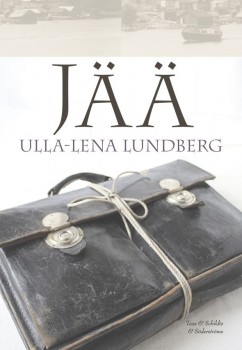 The winner of the Finlandia Prize for Fiction 2012, Ulla-Lena Lundberg’s novel Is (‘Ice’), also turned out to be the winner of the ‘Shadow Finlandia’ prize of the Academic Bookstore in Helsinki. The novel, set on the Åland islands in postwar years, was simultaneously published in Finnish as Jää. This book trade prize is awarded to the best-selling title of the six finalists on the Finlandia Prize list.
The winner of the Finlandia Prize for Fiction 2012, Ulla-Lena Lundberg’s novel Is (‘Ice’), also turned out to be the winner of the ‘Shadow Finlandia’ prize of the Academic Bookstore in Helsinki. The novel, set on the Åland islands in postwar years, was simultaneously published in Finnish as Jää. This book trade prize is awarded to the best-selling title of the six finalists on the Finlandia Prize list.
The best-selling Finnish debut work in the Academic Bookstore was Nälkävuosi (‘The hunger year’, Siltala) by Aki Ollikainen.
Also number one on the December list of best-selling Finnish fiction titles compiled by the Finnish Booksellers’ Association was Lundberg’s novel – in its Finnish translation; the original Swedish-language book came number ten on the same list.
Number two was Sofi Oksanen’s new novel set in Estonia, Kun kyyhkyset katosivat (‘When the doves disappeared’, Like), and number three the hilarious graphic story, Piitles. Tarina erään rockbändin alkutaipaleesta (‘Beatles. The story of the first stage of a rock band’, Otava), by Mauri Kunnas who has written and illustrated dozens of children’s books.
In first and second place on the translated fiction list were J.K. Rowling and J.R.R. Tolkien (The Casual Vacancy, The Hobbit or There and Back Again).
Children chose Finnish books in December – or rather their parents did, buying them as Christmas presents – for the first four places were taken by popular writers such as Sinikka and Tiina Nopola, Aino Havukainen & Sami Toivonen, Mauri Kunnas (Piitles is for mums and dads, not kids!) and Timo Parvela.
On the non-fiction list there was a selection of world record books, cookbooks and biographies – not unusual, considering the season – but number one was Kaiken käsikirja (‘Handbook of everything’) by astronomer and popular writer Esko Valtaoja. A present for all occasions, then?
All my loving
15 February 2013 | This 'n' that
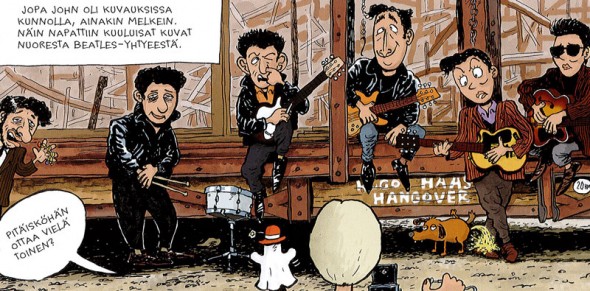
(Early days in Hamburg) Even John behaved himself in the photo sessions, at least almost. This is how the famous photos of the young Beatles were taken.
–Should I take one more? (Astrid the photographer)
One day in the antediluvian times of dawning Beatlemania, a schoolboy in a Finnish small town found himself smitten head over heels by the new pop songs by (probably) the most famous band in the world ever (so far). Like some two billion other teenagers, he learnt by heart every single song the Beatles recorded. Yeah!
The schoolboy grew up and became the illustrator and writer Mauri Kunnas (born 1950), whose storybooks, mostly for children, have now been translated into 30 languages.
But his interest in the Fab Four never left him, and last year he published his illustrated history of John, Paul, George and Ringo, from the day they were born to the day when Please, Please Me / Ask Me Why became number one in the British Top 20 in 1962. As the book is partly written in his native local dialect, its title is Piitles. Tarina erään rockbändin alkutaipaleesta (‘Beatles. The story of the first stage of a rock band’, Otava, 2012).
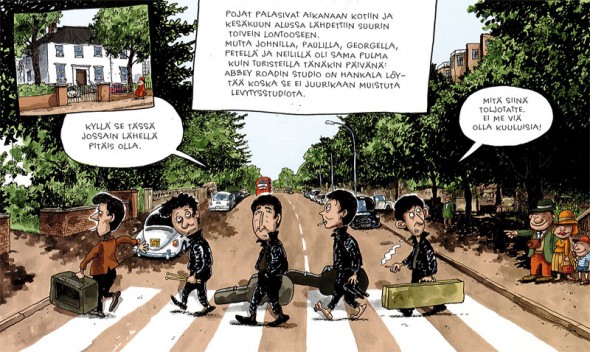
At last the boys came home from Germany, and in June 1962 they left for London with high hopes. But John, Paul, George, Pete and Neil had the same problems that tourists experience even today: The Abbey Road studio is hard to find because it doesn’t look like a recording studio. – It ought to be around here somewhere. – What are you staring at, we’re not famous yet!
In this 77-page graphic story the Beatles grow from babies into celebrities. The large number of hilarious visual details keeps the reader vigilant: for example, in their early days on Hamburg’s Reeperbahn John, Paul, George and Pete (Best) stay in lodgings behind a cinema that are less than hygienic, so on closer examination the lads turn out to be wearing underpants with yellow spots.
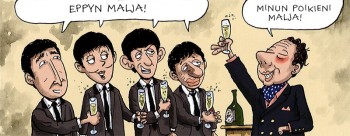
–To Eppy! –To my boys!
Julia Lennon, Klaus Voormann, Astrid Kirchherr, Stuart Sutcliffe, Cynthia, Brian Epstein, George Martin: the faces in the gallery of characters are instantly recognisable. Piitles illustrates how Beatlemania was born, and it is truly the work of a faithful fan.
Genuine beauty
14 February 2013 | Fiction, Prose
Erään ihailijan päiväkirjasta (‘From the diary of an admirer’), a story published in the collection of short prose Taskunovellit (‘Pocket stories’, edited by Vilja-Tuulia Huotarinen; Karisto, 2013)
10.6.
Dear Diary, I have met a wonderful man. He is tender, handsome and clever. It is a real piece of luck that fate didn’t throw us together until now: I’m embarrassed at the very thought that he might have seen me a couple of years ago, as an immature and childish sixth-former. His name is Petri Tamminen and he’s a writer. Writers are gorgeous. Not all of them, of course, some of them think too much of themselves and appear e.g. on television, but Petri is gorgeous.
15.6.
Dear Diary, he has shown me the road to a new world: we went to the Åland islands. Petri doesn’t like Helsinki, he wants to get away from the beaten track of everyday life. The sun sank into the horizon at Eckerö, and my soul floated up into the summer night. This is love. In the morning, in the hotel bed, he recited a poem for me. I have read all his novels and I know that one day they will receive the recognition they deserve, but in his deepest self he is a poet.
16.6.
Dear Diary, we went fishing. Petri caught a sea-trout. It was enormous. He gathered herbs from a shoreline meadow, seasoned the fish and baked it over the embers. We ate with our fingers, fed each other. Delicious. Certain much weaker chefs try to make their names by preparing food e.g. on television. Losers. More…
Jörn Donner: Mammuten [The mammoth]
14 February 2013 | Mini reviews, Reviews
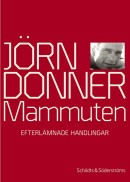 Mammuten. Efterlämnade handlingar
Mammuten. Efterlämnade handlingar
[The mammoth. Leftover business]
Helsinki: Schildts & Söderströms, 2013. 1,128 p., ill.
ISBN 978-951-152-311-54
€37.90, hardback
Finnish translation:
Mammutti. Jälkeenjääneet tekoset
Helsinki: Otava, 2013. 1,087 p., ill.
Suom. [Translated by] Kari Koski
ISBN 978-951-126-311-1
€69,90, hardback
Born in 1933 to a Swedish-speaking family in Helsinki, Jörn Donner, a prominent figure in Finland and Sweden for decades, has published some sixty books. His novel Far och son (‘Father and son’) won him the Finlandia Prize for Fiction in 1985. He has directed and produced films; as a producer he received an Academy Award for Ingmar Bergman’s film Fanny and Alexander. Donner has served two terms in the Finnish Parliament and one in the European Parliament, and represented or supported five different political parties, from the Moscow-loyal Left to the right-wing National Coalition party. Donner’s life has often been the subject of television programmes and he has never passed up the opportunity for more or less well-considered provocations. When he publishes his autobiography at the age of eighty, expectations are high, but Mammuten does not live up to them. It is a sloppy collage of old newspaper articles and introverted diary entries; what emerges is the picture of a man who is disappointed in almost everything he has achieved in life and who sees most of his human relationships as failures. Strangely enough, of the principles that have guided his restless activity and the goals he has striven for in the longer term, Donner writes almost nothing.
Translated by David McDuff
Location, location, location
11 February 2013 | Articles, Non-fiction
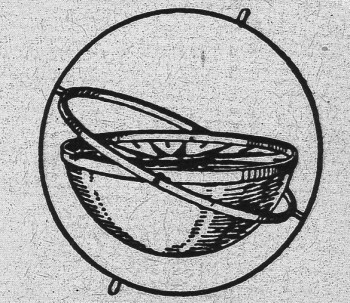
Before GPS: compass and and gimbal, 1570. Picture: Wikimedia
Art that requires navigation systems? Whatever next. In his column poet and writer Teemu Manninen wonders whether literature can function as ‘locative’. How to blend technology and art? Perhaps literature too might expand from the printed word
What if the Romantic poet John Keats had never published his poetry in print – if his works had been distributed only in manuscript form and read only by his friends and acquaintances? Had that been the case, the only way of hearing his poetry would have been at the salons and informal clubs that took place in literary people’s homes, at coffee houses, or other meeting places.
Keats might not even have, most likely, been in attendance himself, but maybe someone had a copy of a copy of a fragment of a poem that they might read to the gathered intellectuals and gentlefolk. You would have to have known the right people, have to have been at the right place at the right time to hear ‘Ode to a Nightingale’ read for the first and perhaps for the last time ever.
Or, what if Joyce had never intended for Ulysses to be published for the great reading public at all? What if, instead, he had left copies of each chapter around Dublin in the places where those chapters take place; what if, page by page, he had distributed his work in the actual locations of the events as they happened in his imagination? More…
Elina Lappalainen: Syötäväksi kasvatetut. Miten ruokasi eli elämänsä [Bred for the table. How your food lived its life]
8 February 2013 | Mini reviews, Reviews
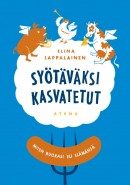 Syötäväksi kasvatetut. Miten ruokasi eli elämänsä
Syötäväksi kasvatetut. Miten ruokasi eli elämänsä
[Bred for the table. How your food lived its life]
Jyväskylä: Atena, 2012. 355 p, ill.
ISBN 978-951-796-843-0
€ 29, paperback
The development of animal welfare depends not only on producers, legislation and control, but also on the preferences of central trading and consumers. In her first book, young journalist Elina Lappalainen describes the conditions in which pigs, cattle and chickens live in Finland before they end up on the table. The living conditions for these are on average better than in many other countries, but they are still often poor. For example, it is difficult to build poultry farms of thousands of chickens, and it matters whether the birds live in cages, are organically grown or a deep litter system is used. Large-scale production does not necessarily mean that pigs, for example, are worse off than they would have been formerly on a small pig farm. On average, the best conditions are provided for cattle, though even most of those spend the long winter in a stanchion barn. Lappalainen has written a thoroughly researched, interesting and balanced review of this internationally important and even emotionally sensitive issue. The book was awarded the prestigious Finlandia Prize for Non-Fiction 2012.
Translated by David McDuff
Runeberg Prize 2013 for poetry
8 February 2013 | In the news
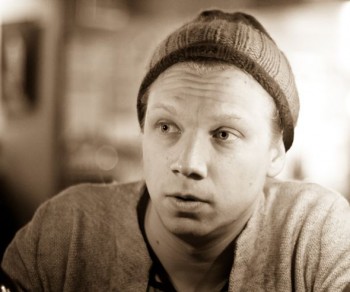
Olli-Pekka Tennilä. Photo: Aleksis Salusjärvi, 2012
The Runeberg Prize for fiction, awarded on 5 February, this year for the twenty-seventh time, went to a book of poetry by Olli-Pekka Tennilä (born 1978).
Tennilä’s second work, Yksinkeltainen on kaksinkeltaista (‘Doubly simple’, a pun: yksinkertainen = simple, kaksinkertainen = double, keltainen = yellow), published by Poesia, makes use of a child’s open-minded use of language and studies the world of the bees. Tennilä is one of the founding members of Osuuskunta Poesia, a poetry cooperative, and is currently its publishing director.
The prize, worth €10,000, was awarded on 5 February – the birthday of the poet J.L Runeberg (1804–1877) – in the southern Finnish city of Porvoo.
The jury, writer Tommi Melender, critic Siru Kainulainen and theatre manager Dan Henriksson – representing the prize’s founders, the Uusimaa newspaper, the city of Porvoo, both the Finnish and Finland-Swedish writers’ associations and the Finnish Critics’ Association – chose the winner from a shortlist of eight books. In their opinion the winning work is both ‘a structurally controlled and expressively vital whole; it demonstrates how the linguistic logic of a small child can be employed again as an adult.’
The other seven finalists were a book of essays, Toinen jalka maassa ja muita esseitä (‘One foot on the ground and other essays’, WSOY) by Markku Envall, two poetry collections, Keisarin tie (‘The emperor’s road’, Otava) by Lassi Hyvärinen and Kuolinsiivous (‘Death cleaning’, WSOY) by Eeva Kilpi, two collections of short stories, Kadonnut ranta (‘Lost shore’, WSOY) by Tiina Laitila Kälvemark and Till dig som saknas (‘To you who are missing’, Schildts&Söderströms) by Peter Sandström, as well as two novels, Rikosromaani (‘Crime novel’, Otava) by Petri Tamminen and Neuromaani (‘Neuromane’, Otava) by Jaakko Yli-Juonikas.

